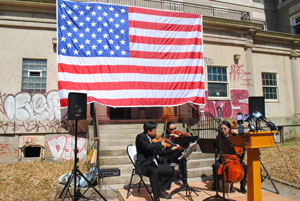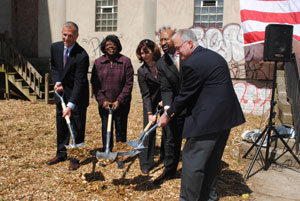 |
Home | En Español | Contact Us | A to Z |
 |
Philadelphia Breaks Ground for the City's
|
|||
 Local musicians providing a musical contrast to the rundown Presser Home site at the groundbreaking. |
The sound of music filled the air on a sunny cool day in April as ground was broken for the renovation of a structure that used to be a home for retired music teachers.
Philadelphia philanthropist and sheet music publisher, Theodore Presser, commissioned the homes which were completed in 1914.
The historic Presser Home for Retired Music Teachers was the backdrop for the groundbreaking of a 45 unit affordable rental apartment complex for seniors aged 62 and older.
"This project will not only provide seniors with excellent, affordable housing, but it will also bring more jobs to Philadelphia," said Mayor Michael Nutter. "It is another great example of Recovery Act dollars at work in our city."
The imposing graffiti covered building currently sits empty on 101 West Johnson Street. Despite its rundown abandoned appearance today, you can still tell it was once a magnificent building that was admired by all.
 Officials ceremoniously breaking ground at the Presser site. Pictured (L-R) are: James Nolen, IV of Nolen Properties, LLC; Honorable Donna Reed Miller, 8th Council District; Holly Glauser-Abel, Pennsylvania Housing Finance Agency; Honorable Michael Nutter, Philadelphia Mayor; and Peter Kaplan, PNC Bank |
It is the first housing development in Philadelphia to use Recovery Act funds. In 2006, with the help of the Preservation Alliance of Greater Philadelphia, this site was listed on the National Register of Historic Places.
Rehabilitation of the building is scheduled for completion in 2011. All of the homes will be targeted toward seniors 62 and older with incomes of $32,700 or less per year. In an effort to remain energy-conscious and control costs, all homes will feature individual heating and air conditioning. The apartment complex will also be renovated to include modern amenities while maintaining the historical integrity of the structure.
HUD provided two million dollars in American Recovery and Reinvestment Act CDBG funding for this development through the City of Philadelphia. Other partners in the effort include the Pennsylvania Housing Finance Agency, Federal Home Loan Bank of Pittsburgh and PNC Bank.

